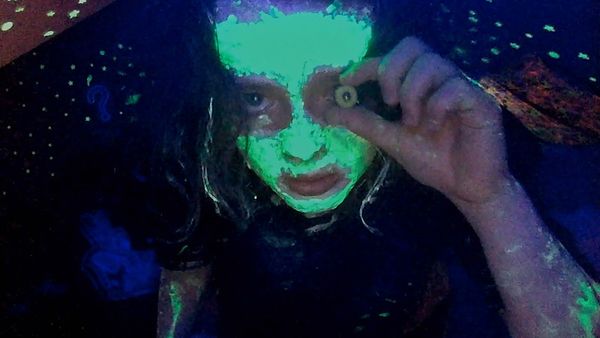Eye For Film >> Movies >> We're All Going to The World's Fair (2021) Film Review
We're All Going to The World's Fair
Reviewed by: Jennie Kermode

You know what they say about the abyss gazing back. Jane Schoenbrun’s extraordinary first feature opens with a deliberately discomfiting shot of the kind most directors wouldn’t dare to use even when firmly established in their careers. It’s a static take, the viewer positioned as if watching through a webcam. A girl of perhaps 14 or 15 years of age is looking directly into the camera. She seems completely at ease, as if unaware that anyone is looking back. Does she know that she’s being watched? Ought we to be looking at this? Is she, in fact, watching us, and simply so comfortable with this form of interaction as to be completely unselfconscious? It’s a moment of forced intimacy which sets the tone for the challenging narrative to follow. It feels too long, and yet it is exactly the right length for what Schoenbrun wishes to achieve, and in every second of it, actress Anna Cobb is telling us something about her character.
She introduces herself as Casey. She has decided to take the World’s Fair Challenge, one of those innumerable emergent forms of online entertainment which accumulate user-generated content to generate an experience as personal as it is anonymous. She likes horror movies, she explains, so she thought it would be fun to live in one. It begins with saying “I want to go to the World’s Fair” repeatedly into the screen, Candyman-style. Players who have done this then report undergoing ‘changes’ which take different forms and develop over a period of days or weeks. They make videos which claim to display these, some more dramatic or grotesque than others. The assumption viewers will begin with is that these are all faked, part of a role-playing game, but of course, we don’t really know – and there lies the rub.
Cinema has really struggled to get to grips with the internet and its associated cultures, probably because most people trying to make films about it haven’t grown up with it and really have very little experience of it at all. Even at their best, they don’t comprehend the different in psychology of young people who have always been at home in this world. It’s probably the biggest generational gulf that humanity has ever had to contend with. Many critics have evidently struggled with it when reviewing this film, trying to fit it into a neat box labelled Experimental (one of those artsy things which one shouldn’t try too hard to understand) or Stranger Danger (young people are out of their depth; we wiser adults see what they don’t). There’s an additional layer of irony to this because the film plays with both these ideas.
The danger which will be most apparent to older viewers comes from an older man, JLB (Michael J Rogers) who befriends Casey online after she decides to leave her webcam running and capture every aspect of her life. His motives are not wholly certain. He claims to want to help or protect her and there may be an extent to which that’s true, but he certainly wants to control her, and his flattery and other grooming techniques lead the way to the suggestion that they meet outside the game, on Skype (i.e. where no-one else can see them). He hides behind a cheesy horror avatar. His questions, though not sexual, become increasingly intimate.
The age gap between the two would seem to create a dangerous power imbalance, but there’s more going on here than that, because JLB is in Casey’s world, and doesn’t understand it as well as he thinks he does. Like most kids her age, Casey is alert to the existence of predators, and whilst his approach does seem to be having an emotional influence on her, he’s completely off guard when it comes to her influence on him. Power shifts back and forth between the two over the course of the film, as he tries to learn more about her through the increasingly disconcerting videos she’s creating for the game.
Although we know little about these characters beyond what they choose to show us, what we do get to see, in great detail, is the relationship between them, and it’s this, along with Casey’s carefully self-directed process of growth, which makes the film compelling. Within this limited landscape it’s tempting to make a big deal out of small things and project onto the characters or invent our own imaginary versions of them. Some criticism for instance, makes a big deal out of Casey’s father shouting at her to keep the noise down in her room, as if this signifies a troubled relationship, but what teenager hasn’t had that experience? Schoenbrun cautions us to be as alert to what we don’t know as to what we do. That’s essential to survival in this world.
Is Casey lonely? JLB thinks so, perhaps forgetting that he is observing a curated version of her life. He may also have a culturally different notion of what constitutes intimacy. Casey uses ASMR to relax, putting her mental well-being in the hands of a trusted stranger. Some people experience physical tingling when exposed to this audio technique. A signal passing through the internet has a physical effect on the body. It’s a reminder that what we call virtual is just another aspect of the real world.
Viewers over 50 may struggle to connect with this film at all, but if they have teenage kids with whom they are experiencing the same problem, they’d do well to try. Viewers under 25 will engage with it easily and very differently. Cobb’s tremendous performance speaks to both these audiences and more. She effectively captures the spirit of an age. This film is long overdue, but perhaps it wasn't possible before members of the internet generation reached an age where they had the power to address these issues in cinema themselves. It captures a moment in time which we will never see again, and whilst it makes a fascinating watch today, its importance will only grow as the years pass.
Reviewed on: 15 Apr 2022
















